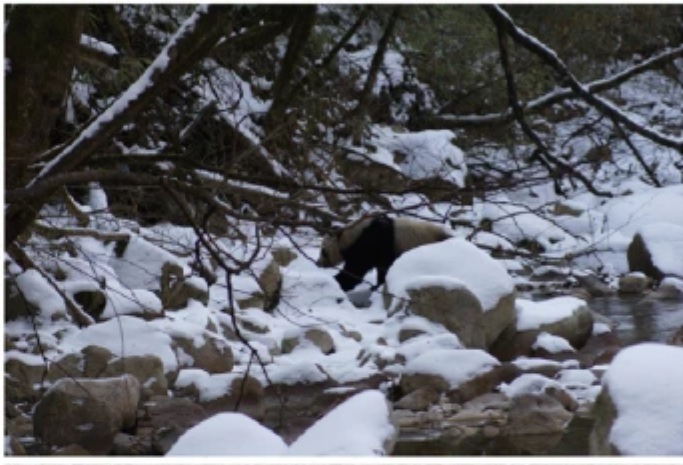Oct 28 2021
Panda Camouflage
 When thinking of highly camouflaged animals, giant pandas are probably not on the short list. Their striking black and white fur pattern, if anything, makes them stand out. This, at least, has been the conventional wisdom, but a new study shows that the panda’s coloration is an effective form of camouflage.
When thinking of highly camouflaged animals, giant pandas are probably not on the short list. Their striking black and white fur pattern, if anything, makes them stand out. This, at least, has been the conventional wisdom, but a new study shows that the panda’s coloration is an effective form of camouflage.
When we think of animals with camouflage we generally imagine those with dull mottled colors matching their surroundings, or perhaps the uniform tawny color of animals who live and hunt in tall grass. Animals with striking or bold coloration don’t come to mind. But camouflage can take many forms, and when judging how effective it is we need to consider several contextual factors, including surroundings, distance, and the viewer.
When we view pandas it is usually in an unnatural setting, not in their native habitat. Because they are reclusive, pictures of giant pandas in their native environment are rare, but the researchers were able to obtain enough photos of pandas to perform an analysis. We also tend to view pandas relatively close up. This is a variable you might not think of right away. It turns out that the black and white pattern on pandas is good for disrupting their overall outline. This camouflage strategy is most effective at long distance.
It’s easy to imagine why animals might evolve camouflage that is more effective at distance. Close up, predators can rely on other sensory information to detect their potential prey, such as sound and smell. The effectiveness of camouflage, especially for a very large animal like a panda, is therefore limited at short distances. But camouflage may be highly effective at longer distances, preventing a predator from detecting the panda in the first place. Long distance camouflage may also have a statistically greater advantage, as there is more likely to be a predator within a larger range.
Further, we can’t assume that our primate vision is typical for the predators that a species is concerned about. Felines and canines have different visual systems than humans, so the researchers applied filters to simulate their visual systems when analysis the panda photos. They found that the fur pattern of the giant pandas was very effective camouflage (as effective as animals traditionally thought of as highly camouflaged) when viewed in their natural habitat, at distance, and with the visual systems of their likely predators. This seems counterintuitive because we are used to seeing them close up in a non-native setting and with human eyes. In technical terms, giant pandas are “cryptic” (not to be confused with “cryptids”, which are mythical animals some believe are real, like Bigfoot).
For further background on camouflage, there are two basic types, background matching (which can be either uniform or mottled) and disruptive coloration. Background matching is what we might ordinarily think of, blending into the background through similar patterns and coloration. Animals can use morphology in addition to color (like leaf or stick insects) for disguise. They can also use foreign objects, such as sand spiders covering themselves with sand. Disruptive coloration makes it difficult to judge the edges, size, or distance of an animal. Zebras are a great example. They live in herds, so hiding their presence is not a useful strategy. Instead their striped pattern makes them blend together in the herd, so a predator would have a hard time picking out one zebra from the herd.
Interestingly, chameleons, often portrayed in popular culture as the epitome of background matching camouflage, do not change colors for this reason. They change colors as a form of communication, such as warning other chameleons of the presence of a predator. They do not blend in with their background. The animal that should be the poster child for dynamic camouflage are the cephalopods. They can change skin color almost instantly to match their surroundings. Expert Hanlon says:
“Cephalopods are the most changeable animal on earth for camouflage,” Hanlon says. “There is no animal group that can equal it for speed or diversity of disguise. They have the widest range of patterns and they have the fastest change. Therefore, they are a good model to help unravel the general principles of camouflage.”
The idea of animal camouflage is ancient, and even Aristotle commented on the fabulous color-changing abilities of cephalopods. Early scientific work was done by Edward Foulton, who was an early evolutionary biologist. Another early biologist writing about camouflage was Abbott Handerson Thayer, who wrote Concealing-Coloration in the Animal Kingdom. Thayer became a cautionary tale, as outlined in an essay by Stephen J. Gould, because he made a classic mistake of overapplying a valid principle. He believed that all animal coloration could be explained through principles of camouflage. This led to his absurd attempts at explaining the coloration of flamingos, arguing that their pink color would be good camouflage with a setting sun in the background.
Obviously, animals use coloration for various reasons, and avoiding being seen is only one. Coloration can also be used as a warning or for intimidation (like the large eye-spots on some butterflies). Coloration is also used to attract mates, perhaps most dramatically among birds. Male birds famously have bright coloration to attract females, while the females, by contrast, can be colored optimally for camouflage. The peacock is an extreme example of this (and Thayer had a tough time trying to explain this away, but he did try).
The giant panda is an example in the other direction – it may not seem at first that their bold coloration is for camouflage, but it turns out it is quite effective in the right context. Pandas are cryptic.






